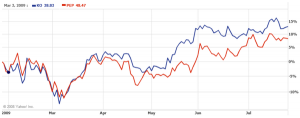Today, we are sending you the first lesson in our 3-part mini Pair Trading Educational Series. Together with our eBook Trade Like a Hedge Fund, these lessons should rapidly help you to choose profitable pair trading signals from PairTrade Finder® PRO for your portfolio.
Pair Trading Educational Series: Lesson 1
Contrary to popular belief, the market has logic to it. The market is efficient most of the time, which is stocks are priced accurately according to all the known and forecast information.
The truest logic running through markets is that of relative value; all assets are worth something in relation to something else.
Take gold for example. When you buy gold you are going short the dollar at the same time. Stocks. When you buy stocks you are going short cash. Stocks, bonds, commodities and currencies are all inter-related markets with different themes running through them at any given time. The price of oil directly affects the profits of oil companies, hence a correlation between oil futures and oil stocks.
Generally the stock market is a forecasting barometer for how the economy will perform over the next 6-12 months. That’s why the stock markets usually bottom before the economy does and vice versa for topping.
Consider the market a big voting machine that represents the collective forecasts of every market participant. Then within the market are different industries, they are priced for their expected growth rates too, then finally within each industry stocks are priced for their individual growth prospects. Generally speaking stocks within the same industry have similar valuations; if one stock is expected to grow a lot more than another stock you will usually find it has a higher valuation, a higher P/E.
The stock market as a whole is also affected by interest rates set by central banks, that’s why it responds dramatically to changes in the expected interest rate.
Many stock valuation models incorporate the risk-free rate of return on government bonds. If bonds are yielding 10%, stocks have to be growing significantly for them to be cheap relative to the risk free rate of return. If interest rates are 1%, stocks don’t have to be so cheap to seem like a good buy.
As you can see the markets are all connected and related to one another in some shape or form.
What about one stock relative to another?
Let’s take Coca Cola and Pepsi traded on the NYSE as an example. Both operate in the non-alcoholic beverages market, they share the same demographic, distribute similar products and will be affected by the same macro-economic and macro-industry conditions. Therefore, both these stocks receive similar valuations and move in a similar fashion. Look at the chart below which shows the stock prices of KO & PEP:

Notice anything here?
Yes, they move very closely to one another. There is a scientifically proven relationship between these two stocks. There is stock price correlation of 90%.
Most of the time these stocks will move in the same fashion, however every now and then they will diverge from one another. This divergence may present a trading opportunity.
Each stock has different institutional shareholders who trade the majority of that stock’s trading volume. These shareholders each have their own agenda, investment mandates and digest and respond to information differently.
Every now and then the institutions will offload a lot of shares or acquire a lot of shares in one stock (say KO), thus moving the stock. If they don’t trade in the other stock (e.g. PEP) it won’t move, but that’s where we, the pair traders, come in.
We arbitrage this opportunity away by buying/selling the other share to be more in line with the one that has moved.
By doing this type of trading we provide liquidity to the market, aide in price discovery, and aide in pricing assets correctly using the theory of relative value.
Therefore there is a value to pair trading – we perform a necessary function to help maintain the efficiency of the marketplace.
We also take an opposing position in the first stock so we remain market and sector neutral, that is general market and sector movements won’t affect our overall position. We are only left with stock-specific risk, that is the risk of an event happening that only affects one stock, not the market or an industry as a whole.
We mitigate the risk of the unknown future stock-specific event adversely affecting us by
keeping position sizing small to overall account size, don’t place more than 10% of your account in one stock.
If done correctly pair trading can result in a 70% or higher win rate on your trades. Not every trade is a winner. However, the more trades you place the higher are your odds of coming out on top, i.e. being profitable.
Think of running your trading business like a casino, except where you are using the technology of PairTrade Finder® PRO to find you trades that have a higher probability of winning on a reward/risk basis, giving you an “edge”, like the house has in a casino. You will make many small bets, win some, lose some, but on average you should come out on top if you have chosen your trades well.
The more trades you make the more likely this outcome will occur. That’s why casinos give you free drinks and parking – they’re not too concerned with your bet sizes but rather how many bets you make, as they hold the “edge”. The longer you sit there and bet, the more likely they will win.
Successful pair trading like any other trading requires strong discipline to cope with the inevitable emotional ups and downs; you have to have the guts to trade consistently every day.
This concludes Lesson 1 in the mini Pair Trading Educational Series. We have given you an overview of how markets function, why they function they way they do and where opportunities exist, and how you can profit from them. In Lesson 2, we will go more in depth into the technique of pair trading.
If you would like to watch a Video Demonstration of how to find historically highly profitable, cointegrated and correlated stock pairs to trade with PairTrade Finder® PRO in UNDER 10 MINUTES, click here.
Happy trading!











